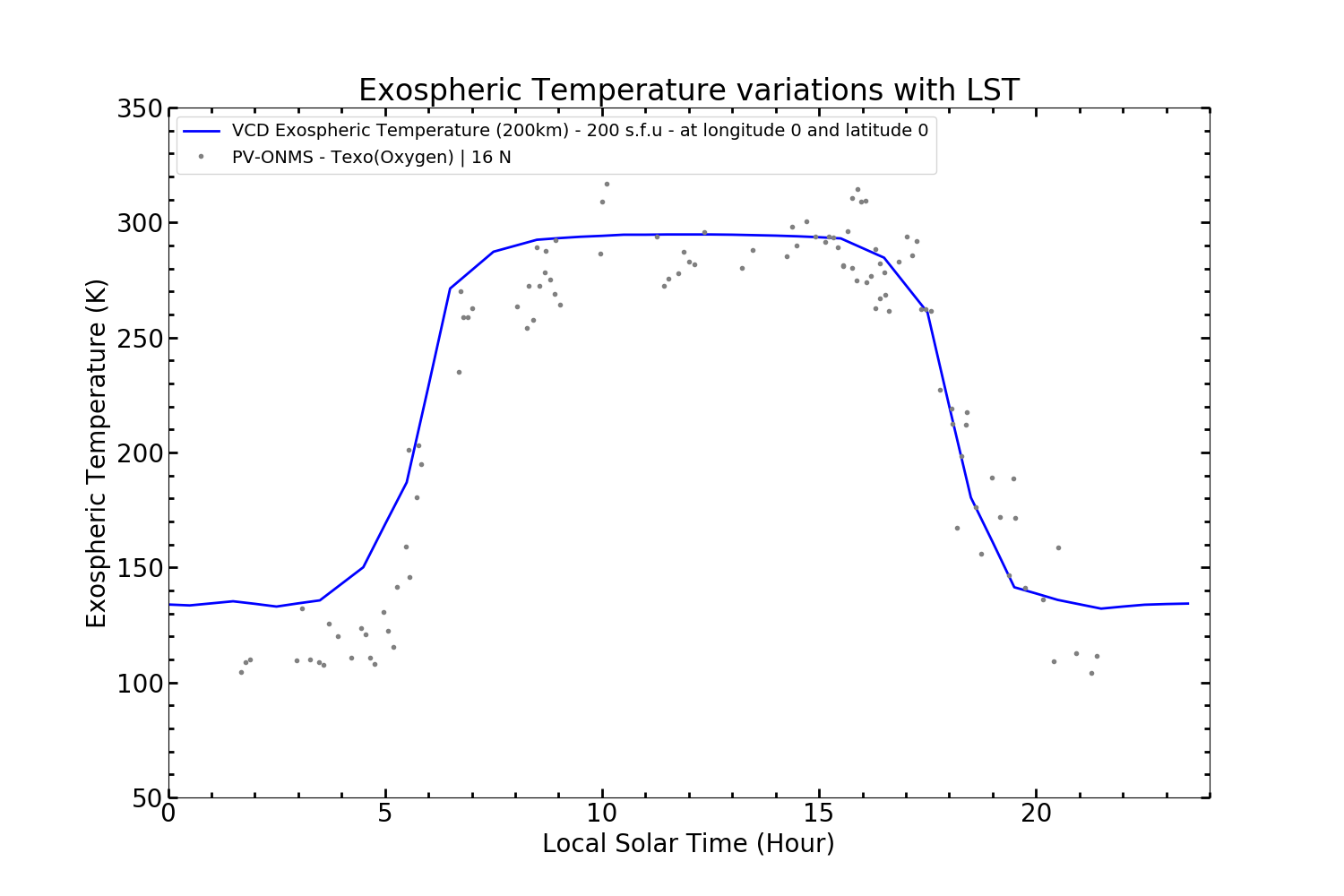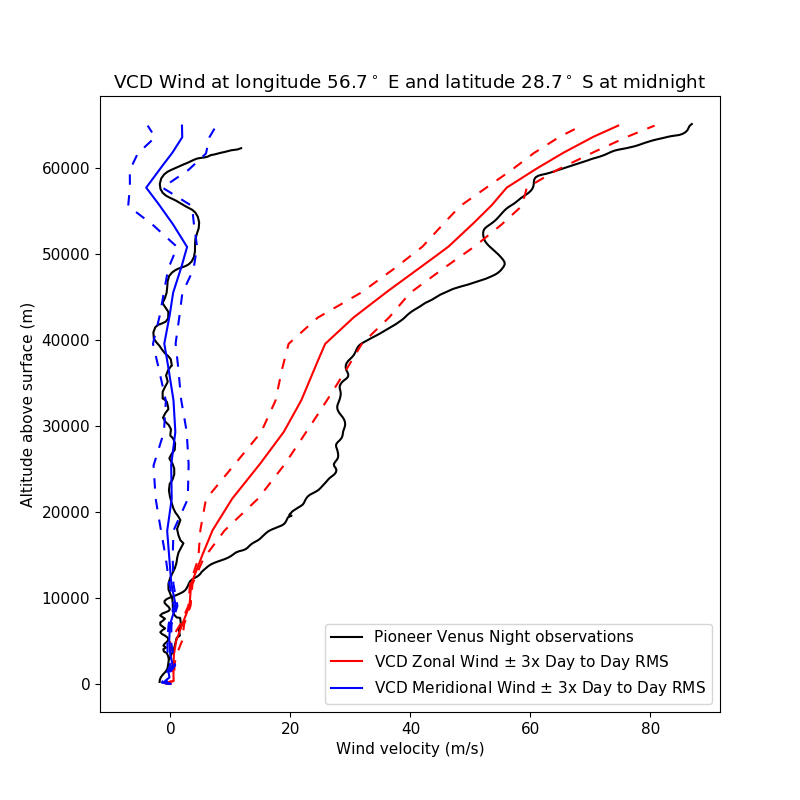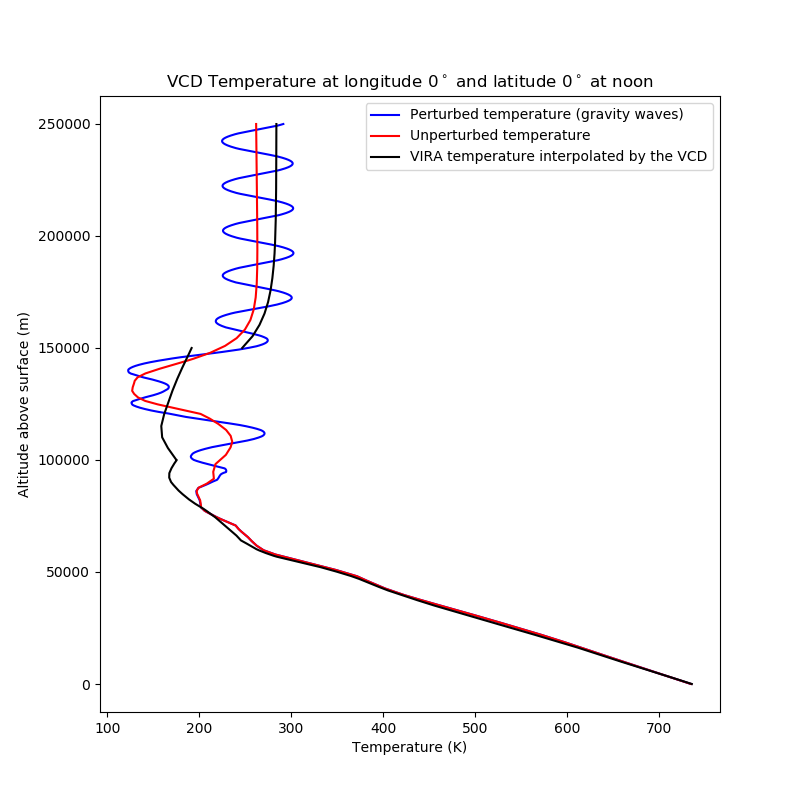The Venus Climate Database
- 1Laboratoire de Meteorologie Dynamique/IPSL, Sorbonne Université, CNRS, Paris, France (sebastien.lebonnois@lmd.ipsl.fr)
- 2LATMOS/IPSL, Sorbonne Université, CNRS, Paris, France
- 3European Space Research and Technology Center (ESTEC), ESA, Noordwijk, The Netherlands
Abstract
The Venus Climate Database (VCD) is based on the outputs of our state-of-the-art Venus Global Climate Model (GCM) [1-3]. This tool, in the footsteps and spirit of its Martian equivalent, the Mars Climate Database (MCD) [4], is intended to be useful for engineers and scientists wanting to compare with their models, analyze observations or plan future missions. This project is funded by the European Space Agency, in the frame of preliminary studies for the EnVision mission to Venus.
Overview of the Venus Climate Database
The VCD provides mean values and statistics of the main meteorological variables (atmospheric temperature, density, pressure and winds) as well as atmospheric composition and related physical fields. It extends from the surface up to and including the thermosphere (~250km). The database contains high resolution temporal outputs (using 24 hourly bins) enabling a good representation of the diurnal evolution of quantities over a climatological Venusian day.

Figure 1: Illustrative example of diurnal variations of the exospheric temperature retrieved from the VCD, compared to PV-ONMS temperature retrievals.
VCD outputs
In addition the main meteorological fields (atmospheric temperature, temperature, density, pressure and winds), the following outputs are available from the VCD:
- Altitudes with respect to the planet center, the reference sphere or above the surface
- Topography
- Astronomical quantities such as Venus Solar Longitude and distance to the Sun at any input Earth date
- Surface temperature (K) and pressure (Pa)
- Venusian hourly and day to day variability (RMS) of main meteorological fields
- Short Wave and Long Wave fluxes at any altitude
- Atmospheric scale height, mean molar mass, speed of sound, reduced gas constant, heat capacity, specific heat ratios and vicosity
- Volume mixing ratios and columns of CO2, CO, O2, O, H, H2, H2O, SO2, SO, OCS, O3, HCl, N2 and He
- An estimation of vertically integrated O2 nightglow
- VIRA (Venus International Reference Atmosphere) temperature, density and pressure at the same location
VCD scenarios
As the goal of the VCD is to provide information about the state of the Venusian atmosphere, various realistic settings have been used to run a series of baseline GCM simulations, namely:
- Simulations using various Extreme UltraViolet (EUV) input from the Sun, as this forcing influences significantly the thermosphere (~120km and above). In practice three cases (solar minimum, average and maximum) using fixed E10.7 forcings are provided. The user also has the possibility to obtain outputs corresponding to a chosen E10.7, which may either be specified as a set value or that corresponding to an actual Earth date. In these cases interpolation from the encompassing EUV scenarios is used to estimate the state of the system.
- To realistically bracket the state of the atmosphere below the thermosphere, which may vary with long-term changes (over time scales of many Venusian days) of the UV cloud albedo [5], along with the baseline case, two supplementary scenarios where that albedo is under and over-estimated are also provided.
Figure 2: Illustrative example of temperature profiles retrieved from the VCD using the various EUV scenarios.
VCD main features
In addition to the aforementioned VCD scenarios, the following features are available:
- A “high resolution mode” : although the GCM simulations have been run at the resolution of a few degrees in longitude and latitude (3.75° x 1.875°), using some post-processing and a high resolution topography map (at 23 pixels/degree) to adjust the local pressure (and density).
- Access to the Venusian intra-hour variability (RMS) of main meteorological variables, as well as the Venusian day-to-day variability thereof, as estimated from the multiple Venus days of GCM simulations.
- The possibility to add perturbations to the climatological fields as:
- Small-scale perturbations, representative of gravity waves (which are unresolved in the GCM, but accounted for via adequate parametrizations [3].
- Large-scale perturbations, representative of actual weather systems present in the GCM simulations.

Figure 3: Illustrative example of wind profiles retrieved from the VCD, compared to Pioneer Venus Night probe observations

Figure 4: Illustrative example of a climatological temperature profile, along with a perturbed one (using the small-scale perturbation scheme) and VIRA reference values.
VCD maccess modes and availability
At the time of writing this abstract, we are finalizing a prototype. We plan to release a first version of the VCD in September 2021. Based on our experience with the MCD, the VCD will be distributed as:
- A main Fortran subroutine that users can interface and directly call from their own software. Interfaces to call this gateway routine using other programming languages (e.g. C, Python, IDL, Matlab, …) will also be available.
- A web interface, based on the MCD one (at http://www-mars.lmd.jussieu.fr), for quick looks will be set up and maintained on http://www-venus.lmd.jussieu.fr
Bibliography
[1] S. Lebonnois et al. Wave analysis in the atmosphere of Venus below 100 km altitude, simulated by the LMD Venus GCM, Icarus, 278:38-51, 2016.
[2] G. Gilli et al. Thermal structure of the upper atmosphere of Venus simulated by a ground-to-thermosphere GCM, Icarus, 281:55-72, 2017.
[3] I. Garate-Lopez and S. Lebonnois. Latitudinal variation of clouds’ structure responsible for Venus’ cold collar, Icarus, 314:1-11, 2018.
[4] The Mars Climate Database http://www-mars.lmd.jussieu.fr
[5] Y. J. Lee et al., Long-term variations of Venus’ 365-nm albedo observed by Venus Express, Akatsuki, MESSENGER, and Hubble Space Telescope, Astron. J., 158:126, 2019.
How to cite: Lebonnois, S., Millour, E., Martinez, A., Pierron, T., Forget, F., Spiga, A., Chaufray, J.-Y., Montmessin, F., and Cipriani, F.: The Venus Climate Database, European Planetary Science Congress 2021, online, 13–24 Sep 2021, EPSC2021-234, https://doi.org/10.5194/epsc2021-234, 2021.

